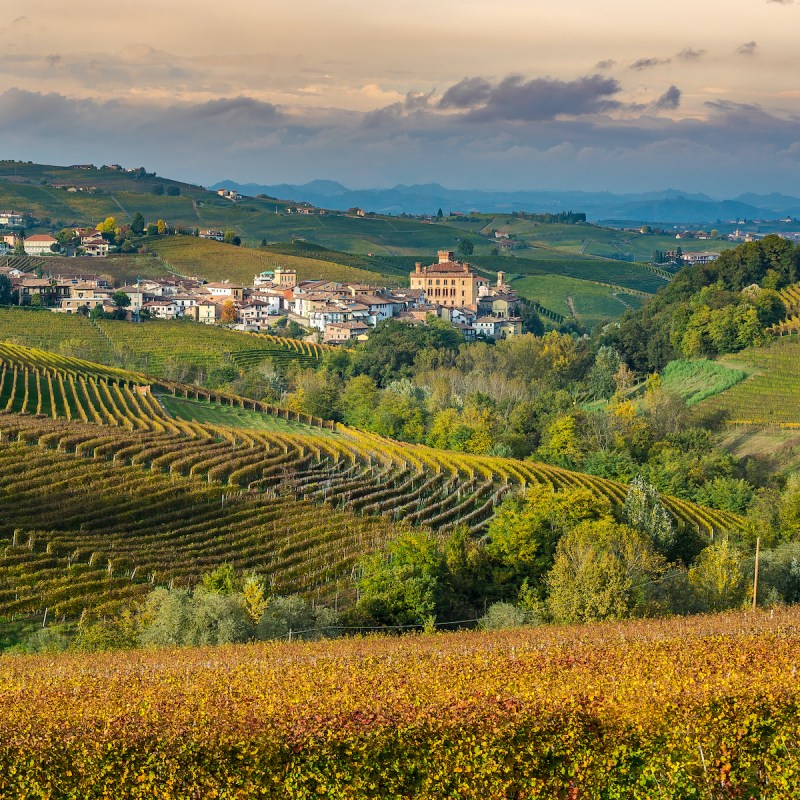
(illpaxphotomatic / Shutterstock.com)
When we first decided Piedmont was a must-visit, we had my milestone birthday in our sights, plus visions of all-we-could-eat truffles to go along with the rich red wines we planned on drinking. “We” being me and three of my close friends and fellow wine travelers. Together, we had already done trips to the Loire and Alsace wine regions. This was to be our third one.
Videos by TravelAwaits
Unfortunately, the coronavirus pandemic intervened. When it was clear we wouldn’t be taking off in time for my birthday in Spring 2020 — or anytime soon — we decided to do a birthday toast by Zoom, each purchasing a bottle of the same wine so that we’d “share” it. That sparked a 2-year-long series of regular happy hours where we sampled wines from France, Spain, and Piedmont. Finally, this April with pandemic restrictions easing and a lull in new variants, we saw a window to venture out.
I’d been introduced to Italian wines during Kevin Zraly’s Windows on the World Wine School course, and again while studying for the London-based Wine and Spirit Education Trust’s Advanced Wine Certificate and taking its diploma course. But other than a standout here and there, my initial reaction to Barolo’s great reds had been indifference bordering on displeasure. I just couldn’t get excited about their bitter tannic heft and bracingly high acidity. In recent years though, I had become more and more curious about Barolo. Nebbiolo, the great grape variety of the Piedmont region, reaches its finest expression here.
We decided between my wine expertise and my friend Ronni’s passion for seeking out food and restaurants — the late, great, and sorely missed Chowhound had nothing on her — we could manage our own planning. Armed with plenty of enthusiasm, adventurous palates, and in my case, a newly renewed passport, we were ready to explore.
Pro Tip: Don’t wait until the last minute to renew an expired or close to expiring passport. Although the months-long processing backlogs have definitely been greatly reduced, if you want to have your new passport in hand without a down-to-the-wire tap dance of nerves and phone calls to the State Department’s (extraordinarily unhelpful) helpline, allow yourself 6 weeks and spring for the extra costs of expedited processing and overnight mailing.
Piedmont’s Barolo appellation (a delimited wine region designated by the Italian wine regulating body) comprises 11 communes that produce some of the world’s greatest and longest-lived red wines. Nebbiolo is the star player, but it’s not the only game in town — not even close. Piedmont’s other red varieties are barbera, dolcetto, and friesa (in small quantities). Whites include arneis, cortese, moscat bianco (as in Moscato d’ Asti and Asti Spumante), chardonnay, and to my surprise and utter delight, riesling — Germany’s foremost white variety.

(Photo Credit: Deborah Adeyanju)
Women-Owned Wineries
We decided to spend our first night in Turin, Italy’s fourth-largest city and the gateway to the Piedmont wine region. From there we’d make the 50-minute journey to Alba, where we planned to base ourselves for three nights before spending our final night in Asti. We’d hit two wineries a day, chosen based on my experience with tasting the wines, each producer’s range of offerings (we wanted to taste Barbaresco and Barolo, and whites as well as red wines), and making sure to hit some of the most important communes, namely Alba, Asti, Barolo, La Morra, and Serralunga d’Alba. To our delight, half of the wineries we chose had a little something extra; they were owned, run by, or have women winemakers.
Pro Tip: You need a reservation to visit wineries. Most accept bookings online via their websites or by just emailing the winery directly. It was really easy to set appointments, choose our tasting experience, and communicate with the wineries. You may be asked to provide proof of COVID vaccination.

(Photo Credit: Deborah Adeyanju)
1. Massolino
Serralunga d’Alba, Italy
Our first visit was to this family winery. The Massolino family’s roots in Serralunga run deep. The family has been hard at it since 1896, growing and selling agricultural products including hazelnuts (Nutella anyone?), one of Piedmont’s most famous and widely exported agricultural products. Now in its third generation of family ownership, the winery counts seven members of the family on its 20-person team.
Like nearly all the wineries we visited, Massolino makes both red and white wines, including an entry-level Langhe Nebbiolo, a Barolo Classico, single-vineyard Barolos, Moscato d’Asti, and a dry riesling from vines planted at high altitude in 2009 after brothers Franco and Roberto Massolino “fell in love” with the variety.
What To Try At Massolino
The 2020 Langhe Riesling was aged for 12 months in terracotta amphorae. Tasting it revealed fresh citrus, zingy green apple, and stone fruit flavors, a crisp saline note, and chalky minerality that went down easily on a gorgeous day. Since Barolos need to be aged for at least 3 years before being released, we didn’t taste any from 2020. But we were told 2020 was “a great vintage” in PIedmont.

(Erick Margarita Images / Shutterstock.com)
2. G.D. Vajra
Barolo, Italy
“You can choose quantity or quality — you can’t have both.”
Everything — from harvesting to sorting to removing the grape stems before winemaking — is done by hand at G.D. Vajra. Grapes are sorted three times to separate the underripe or problematic ones from the ones deemed good enough for winemaking. Our guide Valentina explained that it’s because the family’s winemaking philosophy is “you can choose quantity or quality. You can’t have both.”
Vajra’s wines deliver quality in spades. All the wines we tasted hit their mark, especially the 2018s. The highlight of our visit was getting to meet the family’s matriarch, Milena, who stopped into the tasting room to chat with us at the end of our visit.
What To Try At G.D. Vajra
Try any and all of the Dolcettos. These were varied, with expressive red fruit and spice flavors. Dolcetto is a great, easy-drinking, and delicious go-to red.

(Photo Credit: Deborah Adeyanju)
3. Ca’ Del Baio
Treiso, Italy
Ca del Baio is famous for its Barbarescos (including an outstanding 2019 from the Vallegrande vineyard). The fifth generation of the Grasso family now runs the winery. The lineup includes Langhe reds, (all made from the nebbiolo grape), Dolcetto d’Alba, an elegant and minerally riesling crafted from high-altitude vineyards, and of course Moscato d’Asti.
What To Try At Ca’ Del Baio
The Valentine Langhe Chardonnay is clearly winemaker Valentina Grasso’s passion project. With its smoke and hazelnut aromas, creamy texture, and layered, silky palate, it could easily be mistaken for a white Burgundy. 2019 was the first vintage released.

(Photo Credit: Deborah Adeyanju)
Bonus: Dining With (Michelin) Stars
I mentioned Piedmont is a foodie paradise, didn’t I? Truffles, both black and white, are plentiful here. The white in particular is highly prized and priced to match. Eataly was born here (the first store opened in Turin), gourmet chocolate, Bicerin (its own variation on coffee), hazelnuts, regional pasta dishes (agnolotti, plin, and tajarin), and the cheese… Mamma mia!
We decided to allow ourselves one big meal splurge, dinner at Piazza Duomo. The three-Michelin-star restaurant is a collaboration between restaurateur Davide Franco, chef Enrico Crippa, and the Ceretto family, which owns Ceretto winery (which we also visited during our trip). The price for the set menu was €270, excluding an optional wine pairing. We were also offered a vegetable course at a €40 supplementary charge, sourced from the restaurant’s organic and biodynamically farmed garden. I didn’t think twice about skipping it, produce couldn’t possibly be worth a supplement, could it? I was not just wrong; I was very wrong. These were some of the freshest, ripest, most flavorful vegetables we’d ever had. Luckily for us, asparagus and fava beans (which were in season), lettuce leaves, peas, and spinach were all included in our set tasting.
Pro Tip: If you have your heart set on experiencing a certain restaurant but can’t snag a reservation, see if the chef has other restaurants in the area. In our case, we initially booked at Piazza Duomo’s casual sister eatery, La Piola, but in the end were able to get a seating at the main restaurant.
Visiting Piedmont was a fantastic experience. First off, seeing friends I hadn’t spent time with in person since 2019 was incredible. Second, locals are used to seeing visitors and are happy to share their knowledge from where to eat to which wineries to visit, dishes to try (at one restaurant we got an impromptu and impassioned lesson from the owner on the difference between white and black truffles), and where to find the closest wine shop. On top of those reasons, between the regional capital of Turin, with its history and museums, Alba’s welcoming charm, vineyards listed as UNESCO World Heritage Sites, and the breathtaking vistas at seemingly every turn, Piedmont offers something for everyone. We left full, happy, and already itching to return.
A Final Tip
The final highlight for me was taking the train through the Alps to France. The 5.5-hour journey was absolutely beautiful, and so much more comfortable than being jammed into a crowded, single-aisle plane!
You can save a lot of money and add to your experience by using the rails, which are comfortable, punctual, and operate at high-speed. My train to Paris left from Turin, while my friend was headed to Turin’s airport. To get there, we took a train from Asti. The 35-minute ride was comfortable, quiet, and only cost €5(!), versus the €130 taxi fare one of us paid to make her early morning flight.
For more travel inspiration, take a look at these other wine and food-focused destinations:

